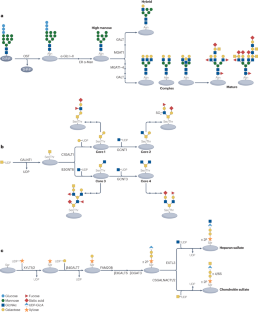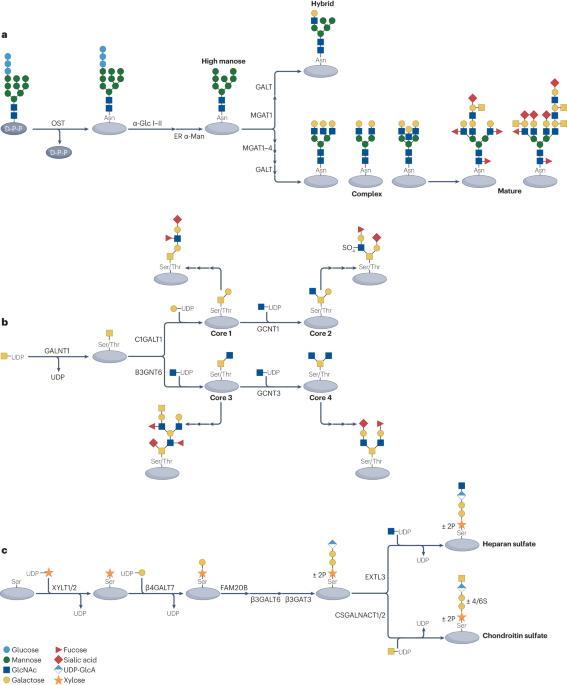Protein glycosylation in cardiovascular health and disease
IF 41.7
1区 医学
Q1 CARDIAC & CARDIOVASCULAR SYSTEMS
引用次数: 0
Abstract
Protein glycosylation, which involves the attachment of carbohydrates to proteins, is one of the most abundant protein co-translational and post-translational modifications. Advances in technology have substantially increased our knowledge of the biosynthetic pathways involved in protein glycosylation, as well as how changes in glycosylation can affect cell function. In addition, our understanding of the role of protein glycosylation in disease processes is growing, particularly in the context of immune system function, infectious diseases, neurodegeneration and cancer. Several decades ago, cell surface glycoproteins were found to have an important role in regulating ion transport across the cardiac sarcolemma. However, with very few exceptions, our understanding of how changes in protein glycosylation influence cardiovascular (patho)physiology remains remarkably limited. Therefore, in this Review, we aim to provide an overview of N-linked and O-linked protein glycosylation, including intracellular O-linked N-acetylglucosamine protein modification. We discuss our current understanding of how all forms of protein glycosylation contribute to normal cardiovascular function and their roles in cardiovascular disease. Finally, we highlight potential gaps in our knowledge about the effects of protein glycosylation on the heart and vascular system, highlighting areas for future research. Protein glycosylation is vital to the regulation of cell function, and changes in this post-translational modification underlie many disease processes. In this Review, Chatham and Patel discuss how protein glycosylation contributes to normal cardiovascular function and its role in cardiovascular disease, identifying important knowledge gaps and areas for future research.


心血管健康和疾病中的蛋白质糖基化
蛋白质糖基化涉及碳水化合物与蛋白质的连接,是最丰富的蛋白质共翻译和翻译后修饰之一。技术的进步大大增加了我们对蛋白质糖基化所涉及的生物合成途径以及糖基化变化如何影响细胞功能的了解。此外,我们对蛋白质糖基化在疾病过程中的作用的认识也在不断加深,尤其是在免疫系统功能、传染病、神经变性和癌症方面。几十年前,人们就发现细胞表面糖蛋白在调节心肌肌膜上的离子转运中起着重要作用。然而,除了极少数例外情况,我们对蛋白质糖基化变化如何影响心血管(病理)生理学的了解仍然非常有限。因此,在本综述中,我们旨在概述N-连接和O-连接的蛋白质糖基化,包括细胞内O-连接的N-乙酰葡糖胺蛋白质修饰。我们将讨论我们目前对所有形式的蛋白质糖基化如何促进正常心血管功能及其在心血管疾病中的作用的理解。最后,我们强调了我们在蛋白质糖基化对心脏和血管系统的影响方面可能存在的知识空白,并着重指出了未来的研究领域。
本文章由计算机程序翻译,如有差异,请以英文原文为准。
求助全文
约1分钟内获得全文
求助全文
来源期刊

Nature Reviews Cardiology
医学-心血管系统
CiteScore
53.10
自引率
0.60%
发文量
143
审稿时长
6-12 weeks
期刊介绍:
Nature Reviews Cardiology aims to be the go-to source for reviews and commentaries in the scientific and clinical communities it serves. Focused on providing authoritative and accessible articles enriched with clear figures and tables, the journal strives to offer unparalleled service to authors, referees, and readers, maximizing the usefulness and impact of each publication. It covers a broad range of content types, including Research Highlights, Comments, News & Views, Reviews, Consensus Statements, and Perspectives, catering to practising cardiologists and cardiovascular research scientists. Authored by renowned clinicians, academics, and researchers, the content targets readers in the biological and medical sciences, ensuring accessibility across various disciplines. In-depth Reviews offer up-to-date information, while Consensus Statements provide evidence-based recommendations. Perspectives and News & Views present topical discussions and opinions, and the Research Highlights section filters primary research from cardiovascular and general medical journals. As part of the Nature Reviews portfolio, Nature Reviews Cardiology maintains high standards and a wide reach.
 求助内容:
求助内容: 应助结果提醒方式:
应助结果提醒方式:


